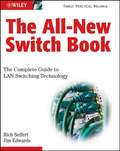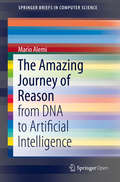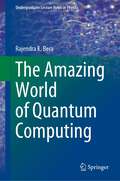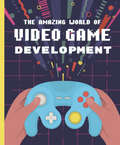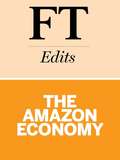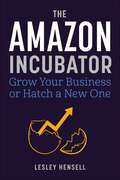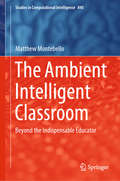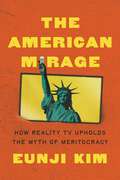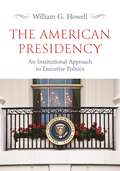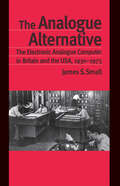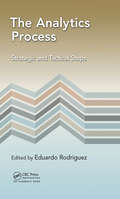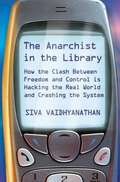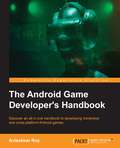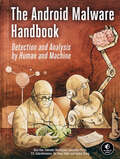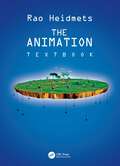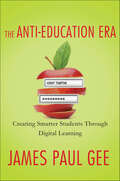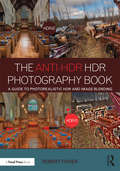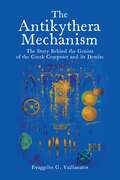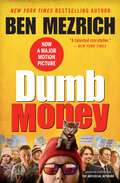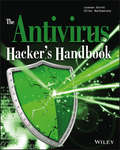- Table View
- List View
The All-New Switch Book
by Rich SeifertThis much-needed update to the bestselling guide on the extensive changes to the local area networks (LAN) switching technologies explains why LAN switching technologies are critical to network design. This in-depth guide covers the capabilities, application, and design of LAN switches and switched internetworks and examines the significant changes that have taken place since the publication of the first edition seven years ago. You're sure to appreciate the witty writing style and easy-to-follow format on such an often-complicated subject matter.
The Amazing Journey of Reason: from DNA to Artificial Intelligence (SpringerBriefs in Computer Science)
by Mario AlemiThis Open Access book explores questions such as why and how did the first biological cells appear? And then complex organisms, brains, societies and –now– connected human societies? Physicists have good models for describing the evolution of the universe since the Big Bang, but can we apply the same concepts to the evolution of aggregated matter –living matter included? The Amazing Journey analyzes the latest results in chemistry, biology, neuroscience, anthropology and sociology under the light of the evolution of intelligence, seen as the ability of processing information. The main strength of this book is using just two concepts used in physics –information and energy– to explain: The emergence and evolution of life: procaryotes, eukaryotes and complex organismsThe emergence and evolution of the brainThe emergence and evolution of societies (human and not)Possible evolution of our "internet society" and the role that Artificial Intelligence is playing
The Amazing World of Quantum Computing (Undergraduate Lecture Notes in Physics)
by Rajendra K. BeraThis book discusses the application of quantum mechanics to computing. It explains the fundamental concepts of quantum mechanics and then goes on to discuss various elements of mathematics required for quantum computing. Quantum cryptography, waves and Fourier analysis, measuring quantum systems, comparison to classical mechanics, quantum gates, and important algorithms in quantum computing are among the topics covered.The book offers a valuable resource for graduate and senior undergraduate students in STEM (science, technology, engineering, and mathematics) fields with an interest in designing quantum algorithms. Readers are expected to have a firm grasp of linear algebra and some familiarity with Fourier analysis.
The Amazing World of Video Game Development
by Denis GalaninThe perfect book for any child who is interested in making a career out of video games, learn about the different roles within a game development company and how a game goes from a thought to a program.
The Amazon Economy
by Financial TimesThe Amazon Economy tells you everything you need to know about Amazon, the technological giant that is now much more than the online retailer founded by Jeff Bezos in 1994. The company’s voracious expansion—into areas ranging from logistics and cloud computing to fashion and movie production—has put it at the head of a wider corporate ecosystem over which it wields extraordinary power. Regulators, politicians, consumers and other businesses ignore it at their peril. Based on a series of articles published by the Financial Times, The Amazon Economy has been specially updated as an e-book by Barney Jopson, U.S. retail correspondent for the global business newspaper and website, with contributions from the FT’s influential Lex columnists, Robert Armstrong and Stuart Kirk, and global media editor, Andrew Edgecliffe-Johnson.
The Amazon Incubator: Grow Your Business or Hatch a New One
by Lesley HensellThe real story about how to be a successful seller on Amazon, from a leading consultant. Amazon is the most powerful business incubator in the history of the world. Unfortunately, where there is great opportunity, get-rich-quick schemes abound. Most available books about selling on Amazon peddle a dream that is unattainable for sellers. They promise riches at the cost of only five hours a week, or a long-term income for an initial investment of just $1,000.The Amazon Incubator is different. This book instead offers realistic, sustainable strategies for building a long-term, profitable business on Amazon. Whether sellers are burgeoning entrepreneurs or own the ecommerce channel at an established brand, they will benefit from the strategic thinking and in-depth Amazon know-how delivered in an easily digestible format. The reader will be guided through exercises to define their goals, determine their product set, and execute like a champ. The Amazon Incubator is written in short, easy-to-digest chapters that include case studies and real-world examples of Amazon seller success and failure. Readers will better identify with and understand the information when case studies are included. In addition, each chapter includes a brief summary at the end, as well as suggested action steps, so it can easily be used as a tool for the reader to share with teammates and business associates.
The Ambient Intelligent Classroom: Beyond the Indispensable Educator (Studies in Computational Intelligence #840)
by Matthew MontebelloThis book explores Ambient Intelligence as applied to the classroom, while especially focusing on the use of personalized education to optimize the learning process. In the years to come, the dynamics of learning spaces in higher education will need to evolve and adapt to a constantly changing digital society, as learners and educators alike attune their learning competences and teaching skills. Ambient Intelligence is another way that Artificial Intelligence is being utilized in a plethora of real-world situations, amongst which classrooms and other learning spaces offer fitting settings and ideal environments for employing this assistive technology.The book presents a complete and novel approach to deploying the Ambient Intelligent Classroom, based on three interrelated aspects – the Social, the Technological and the Educational, – in order to provide a rich three-dimensional learning environment.This book is intended for education technologists and AI researchers, as well as for those tech-savvy readers interested in applying technology to the future of learning spaces. Educators in particular will find valuable insights and guidelines on how to shape the evolution of their own classroom.
The American Midwest: Managing Change in Rural Transition
by Norman WalzerThe rural Midwest is undergoing fundamental changes with increased competition from foreign agriculture; employment shifts from higher-paying manufacturing to lower-paying service industries; the displacement of local small town business by large discount stores and shopping malls; overall population declines that threaten the viability of schools, hospitals, and other public institutions, along with an influx of minority groups that has led to strife in some communities. Using data from the 2000 Census, this collection examines the major demographic and employment trends in the rural Midwestern states with special attention to the issues that state and local policy makers must address in the near future. The contributors are well known experts in their fields, and in these original, previously unpublished materials they offer suggestions on how the Internet and other technological advances offer new opportunities for rural economies that local leaders can build on.
The American Mirage: How Reality TV Upholds the Myth of Meritocracy (Princeton Studies in Political Behavior)
by Eunji KimHow the entertainment narrative of upward mobility distorts the harsh economic realities in AmericaIn an age of growing wealth disparities, politicians on both sides of the aisle are sounding the alarm about the fading American Dream. Yet despite all evidence to the contrary, many still view the United States as the land of opportunity. The American Mirage addresses this puzzle by exposing the stark reality of today&’s media landscape, revealing how popular entertainment media shapes politics and public opinion in an increasingly news-avoiding nation.Drawing on an eclectic array of original data, Eunji Kim demonstrates how, amid a dazzling array of media choices, many Americans simply are not consuming the news. Instead, millions flock to entertainment programs that showcase real-life success stories, such as American Idol, Shark Tank, and MasterChef. Kim examines how shows like these leave viewers confoundingly optimistic about the prospects of upward mobility, promoting a false narrative of rugged individualism and meritocracy that contradicts what is being reported in the news.By taking seriously what people casually watch every day, The American Mirage shows how rags-to-riches programs perpetuate the myth of the American Dream, glorifying the economic winners, fostering tolerance for income inequality, and dampening support for redistributive policies that could improve people&’s lives.
The American Presidency: An Institutional Approach to Executive Politics
by William G. HowellHow institutions shape the American presidencyThis incisive undergraduate textbook emphasizes the institutional sources of presidential power and executive governance, enabling students to think more clearly and systematically about the American presidency at a time when media coverage of the White House is awash in anecdotes and personalities. William Howell offers unparalleled perspective on the world’s most powerful office, from its original design in the Constitution to its historical growth over time; its elections and transitions to governance; its interactions with Congress, the courts, and the federal bureaucracy; and its persistent efforts to shape public policy. Comprehensive in scope and rooted in the latest scholarship, The American Presidency is the perfect guide for studying the presidency at a time of acute partisan polarization and popular anxiety about the health and well-being of the republic.Focuses on the institutional structures that presidents must navigate, the incentives and opportunities that drive them, and the constraints they routinely confrontShows how legislators, judges, bureaucrats, the media, and the broader public shape the contours and limits of presidential powerEncourages students to view the institutional presidency as not just an object of study but a way of thinking about executive politicsHighlights the lasting effects of important historical moments on the institutional presidencyEnables students to grapple with enduring themes of power, rules, norms, and organization that undergird democracy
The Analogue Alternative: The Electronic Analogue Computer in Britain and the USA, 1930-1975 (Routledge Studies in the History of Science, Technology and Medicine #15)
by James S. SmallWe are in the midst of a digital revolution - until recently, the majority of appliances used in everyday life have been developed with analogue technology. Now, either at home or out and about, we are surrounded by digital technology such as digital 'film', audio systems, computers and telephones. From the late 1940s until the 1970s, analogue technology was a genuine alternative to digital, and the two competing technologies ran parallel with each other. During this period, a community of engineers, scientists, academics and businessmen continued to develop and promote the analogue computer. At the height of the Cold War, this community and its technology met with considerable success in meeting the urgent demand for high speed computing for use in the design and simulation of rockets, aircraft and manned space vehicles. The Analogue Alternative tracks the development, commercialisation and ultimate decline of the electronic analogue computer in the USA and Britain. It examines the roles played by technical, economic and cultural factors in the competition between the alternative technologies, but more importantly, James Small demonstrates that non-technical factors, such as the role of 'military enterprise' and the working practices of analogue engineers, have been the most crucial in analogue's demise.^l This book will be of interest to students of the history and sociology of science and technology, particularly computing. It will also be relevant to those interested in technical change and innovation, and the study of scientific cultures.
The Analytics Process: Strategic and Tactical Steps
by Eduardo RodriguezThis book is about the process of using analytics and the capabilities of analytics in today’s organizations. Cutting through the buzz surrounding the term analytics and the overloaded expectations about using analytics, the book demystifies analytics with an in-depth examination of concepts grounded in operations research and management science. Analytics as a set of tools and processes is only as effective as: The data with which it is working The human judgment applying the processes and understanding the output of these processes. For this reason, the book focuses on the analytics process. What is intrinsic to analytics’ real organizational impact are the careful application of tools and the thoughtful application of their outcomes. This work emphasizes analytics as part of a process that supports decision-making within organizations. It wants to debunk overblown expectations that somehow analytics outputs or analytics as applied to other concepts, such as Big Data, are the be-all and end-all of the analytics process. They are, instead, only a step within a holistic and critical approach to management thinking that can create real value for an organization. To develop this holistic approach, the book is divided into two sections that examine concepts and applications. The first section makes the case for executive management taking a holistic approach to analytics. It draws on rich research in operations and management science that form the context in which analytics tools are to be applied. There is a strong emphasis on knowledge management concepts and techniques, as well as risk management concepts and techniques. The second section focuses on both the use of the analytics process and organizational issues that are required to make the analytics process relevant and impactful.
The Anarchist in the Library: How the Clash Between Freedom and Control Is Hacking the Real World and Crashing the System
by Siva VaidhyanathanThis relatively brief book tackles an expansive topic: Internet technology and its effect on our social, political and cultural future. For cultural historian and media scholar Vaidhyanathan (Copyrights and Copywrongs), the digital revolution is about far more than downloading music. Weaving an array of historical examples with prescient analysis, Vaidhyanathan takes the Internet battles common to most readers today-e.g., the well-publicized efforts of the recording industry to stop file-sharing; the practices of those who share music online-to craft a treatise on how technology highlights the eternal cultural struggle between "oligarchy and anarchy."
The Android Game Developer's Handbook
by Avisekhar RoyDiscover an all in one handbook to developing immersive and cross-platform Android games About This Book * Practical tips and tricks to develop powerful Android games * Learn to successfully implement microtransactions and monitor the performance of your game once it's out live. * Integrate Google's DIY VR tool and Google Cardboard into your games to join in on the VR revolution Who This Book Is For This book is ideal for any game developer, with prior knowledge of developing games in Android. A good understanding of game development and a basic knowledge on Android platform application development and JAVA/C++ will be appreciated. What You Will Learn * Learn the prospects of Android in Game Development * Understand the Android architecture and explore platform limitation and variations * Explore the various approaches for Game Development using Android * Learn about the common mistakes and possible solutions on Android Game Development * Discover the top Cross Platform Game Engines and port games on different android platform * Optimize memory and performance of your game. * Familiarize yourself with different ways to earn money from Android Games In Detail Gaming in android is an already established market and growing each day. Previously games were made for specific platforms, but this is the time of cross platform gaming with social connectivity. It requires vision of polishing, design and must follow user behavior. This book would help developers to predict and create scopes of improvement according to user behavior. You will begin with the guidelines and rules of game development on the Android platform followed by a brief description about the current variants of Android devices available. Next you will walk through the various tools available to develop any Android games and learn how to choose the most appropriate tools for a specific purpose. You will then learn JAVA game coding standard and style upon the Android SDK. Later, you would focus on creation, maintenance of Game Loop using Android SDK, common mistakes in game development and the solutions to avoid them to improve performance. We will deep dive into Shaders and learn how to optimize memory and performance for an Android Game before moving on to another important topic, testing and debugging Android Games followed by an overview about Virtual Reality and how to integrate them into Android games. Want to program a different way? Inside you'll also learn Android game Development using C++ and OpenGL. Finally you would walk through the required tools to polish and finalize the game and possible integration of any third party tools or SDKs in order to monetize your game when it's one the market! Style and approach The book follows a handbook approach, focused on current and future game development trend from every possible aspect including monetization and sustainability in the market.
The Android Malware Handbook: Detection and Analysis by Human and Machine
by V.S. Subrahmanian Qian Han Salvador Mandujano Sebastian Porst Sai Deep TetaliWritten by machine-learning researchers and members of the Android Security team, this all-star guide tackles the analysis and detection of malware that targets the Android operating system.This groundbreaking guide to Android malware distills years of research by machine learning experts in academia and members of Meta and Google&’s Android Security teams into a comprehensive introduction to detecting common threats facing the Android eco-system today.Explore the history of Android malware in the wild since the operating system first launched and then practice static and dynamic approaches to analyzing real malware specimens. Next, examine machine learning techniques that can be used to detect malicious apps, the types of classification models that defenders can implement to achieve these detections, and the various malware features that can be used as input to these models. Adapt these machine learning strategies to the identifica-tion of malware categories like banking trojans, ransomware, and SMS fraud.You&’ll:Dive deep into the source code of real malwareExplore the static, dynamic, and complex features you can extract from malware for analysisMaster the machine learning algorithms useful for malware detectionSurvey the efficacy of machine learning techniques at detecting common Android malware categoriesThe Android Malware Handbook&’s team of expert authors will guide you through the Android threat landscape and prepare you for the next wave of malware to come.
The Animation Smears Book: Uncovering Film's Most Elusive Technique
by Christian AvenderThroughout cinema, there have been various techniques to depict motion, and one style in particular is the fascinating use of smears in animation. Incredibly popular and captivating to artists, these animation smears are frames that creatively replicate motion blur captured on film, which is the phenomena that we commonly observe in our everyday life.The vast world of different techniques for smears is explored in this book, expanding way beyond their commonly believed starting point in the 1940s to their actual origins that date back to the beginning of art history with illustrations and prototypes that led to their usage in some of the earliest known theatrical animations.The Animation Smears Book: Uncovering Film’s Most Elusive Technique is a comprehensive guide that provides extensive information on the stylistic and creative aspects of smears and their impact, on how they make use of the way we perceive motion. Additionally, this book also reveals the names of artists who helped develop smears and the original techniques that were used.Thoroughly examined by a professional animator, the animation smear is highlighted as a versatile technique used in all forms of animation including 3D and stop‑motion. This book answers all of the questions that readers ever had about smears and brings clarity to this simple yet mysterious trick that has puzzled fans, scholars, and historians for centuries.
The Animation Textbook
by Rao HeidmetsThis introductory textbook provides practical exercises to help students and beginner animators get to grips with the basics of creating animated films. It covers both traditional 2D and 3D animated film, as well as experimental and computer animation. The first part of the book includes exercises colour-coded by difficult, to guide readers through the activities as they become more challenging. The second part of the book focuses on development, pre-production, production, and post-production to assist you with making your animated films feel more professional. The book also includes information and guidance on how to easily create animation using only a mobile phone. This book will be helpful to all students and newcomers looking to gain a grounding in the basics of animated film.
The Animator's Eye: Composition and Design for Better Animation
by Francis GlebasFirst published in 2011. Routledge is an imprint of Taylor & Francis, an informa company.
The Animator’s Sketchbook: How to See, Interpret & Draw Like a Master Animator
by Tony WhiteThe Animator’s Sketchbook will teach students of animation how to improve their work through observation and drawing. It will show readers how to access their inner "animator." With over 60 different gesture and drawing exercises, this book enhances vision, analysis, understanding, and the core skills required to become a master animator. Filled with extensive practice pages, Tony White’s Sketchbook, invites students to demonstrate what they learn. Each exercise is timed, so that the skills acquired, are optimized for efficiency and comprehension. The style and technique of the art produced will be entirely up to the reader, thus making no two sketchbooks alike. Key Features Provides readers with their own personal sketchbook, demonstrating classical art skills that are highly prized by studio employers Readers will come away better visualizing form, gesture, pose and expression Includes 60 speed and gesture drawing exercises Provides the perfect way for students of animation to improve their core skills Perfect for animation instructors who can rely on this unique course workbook to take their students to new levels of classic visualizing expertise
The Anti-Education Era: Creating Smarter Students through Digital Learning
by James Paul GeeOne of the first champions of the positive effects of gaming reveals the dark side of today's digital and social media Today's schools are eager to use the latest technology in the classroom, but rather than improving learning, the new e-media can just as easily narrow students' horizons. Education innovator James Paul Gee first documented the educational benefits of gaming a decade ago in his classic What Video Games Have to Teach Us About Learning and Literacy. Now, with digital and social media at the center of modern life, he issues an important warning that groundbreaking new technologies, far from revolutionizing schooling, can stymie the next generation's ability to resolve deep global challenges. The solution-and perhaps our children's future-lies in what Gee calls synchronized intelligence, a way of organizing people and their digital tools to solve problems, produce knowledge, and allow people to count and contribute. Gee explores important strategies and tools for today's parents, educators, and policy makers, including virtual worlds, artificial tutors, and ways to create collective intelligence where everyday people can solve hard problems. By harnessing the power of human creativity with interactional and technological sophistication we can finally overcome the limitations of today's failing educational system and solve problems in our high-risk global world. The Anti-Education Era is a powerful and important call to reshape digital learning, engage children in a meaningful educational experience, and bridge inequality.
The Anti-HDR HDR Photography Book: A Guide to Photorealistic HDR and Image Blending
by Robert FisherThe Anti-HDR HDR Photography Book contains everything you’ll need to know in order to get the best results from your High Dynamic Range images. Designed for those who want to extend the dynamic range in their work, but are frustrated by over-processed and hyper-saturated images, this book proves that HDR techniques are capable of producing photographs that are both stunning and realistic. In addition to helping you choose the right equipment and settings to optimize your shoot for HDR, the book explains how to use post-processing software to create natural-looking photographs, blend source images with layer masks, and establish an efficient workflow. By teaching you to effectively use all the most important tools of HDR, it will expand the scope of your portfolio and allow you to create images that you never thought were possible. Key features include: What to look for when choosing a camera for HDR Description of gear that is important to the HDR photographer How to use the HDR software applications Photomatix and SNS-HDR Pro to achieve natural-looking results Discussion of blending multiple source images using simple masks and techniques An in-depth examination of the use of Luminance Masks for blending and editing bracketed images to a photorealistic composite Guide to workflow, from organizing images on the computer to pre-merge editing of RAW files using both Adobe Lightroom and Adobe Bridge The use of black-and-white in HDR and image-blending, including ways to convert color images to black-and-white
The Antikythera Mechanism: The Story Behind the Genius of the Greek Computer and its Demise
by Evaggelos G. VallianatosIn Antikythera Mechanism: The Story Behind the Genius of the Greek Computer and Its Demise, Evaggelos G. Vallianatos, historian and ecopolitical theorist, shows that after the conquest of Persia by Alexander the Great in the late fourth century BCE
The Antisocial Network: The GameStop Short Squeeze and the Ragtag Group of Amateur Traders That Brought Wall Street to Its Knees
by Ben MezrichFrom one of our most innovative and celebrated authors, the definitive take on the wildest story of the year— the David-vs.-Goliath GameStop short squeeze, a tale of fortunes won and lost overnight that may end up changing Wall Street forever.Bestselling author Ben Mezrich offers a gripping, beat-by-beat account of how a loosely affiliate group of private investors and internet trolls on a subreddit called WallStreetBets took down one of the biggest hedge funds on Wall Street, firing the first shot in a revolution that threatens to upend the establishment.It&’s the story of financial titans like Gabe Plotkin of hedge fund Melvin Capital, one of the most respected and staid funds on the Street, billionaires like Elon Musk, Steve Cohen, Mark Cuban, Robinhood co-CEOs Vlad Tenev and Baiju Bhatt, and Ken Griffin of Citadel Securities. Over the course of four incredible days, each in their own way must reckon with a formidable force they barely understand, let alone saw coming: everyday men and women on WallStreetBets like nurse Kim Campbell, college student Jeremy Poe, and the enigmatic Keith &“RoaringKitty&” Gill, whose unfiltered livestream videos captivated a new generation of stock market enthusiasts.The unlikely focus of the battle: GameStop, a flailing brick-and-mortar dinosaur catering to teenagers and outsiders that had somehow held on as the world rapidly moved online. At first, WallStreetBets was a joke—a meme-filled, freewheeling place to share shoot-the-moon investment tips, laugh about big losses, and post diamond hand emojis. Until some members noticed an opportunity in GameStop—and rode a rocket ship to tens of millions of dollars in earnings overnight.In thrilling, pulse-pounding prose, THE ANTISOCIAL NETWORK offers a fascinating, never-before-seen glimpse at the outsize personalities, dizzying swings, corporate drama, and underestimated American heroes and heroines who captivated the nation during one of the most volatile weeks in financial history. It&’s the amazing story of what just happened—and where we go from here.
The Antitrust Paradigm: Restoring a Competitive Economy
by Jonathan B. BakerAt a time when tech giants have amassed vast market power, Jonathan Baker shows how laws and regulations can be updated to ensure more competition. The sooner courts and antitrust enforcement agencies stop listening to the Chicago school and start paying attention to modern economics, the sooner Americans will reap the benefits of competition.
The Antivirus Hacker's Handbook
by Elias Bachaalany Joxean KoretThe book focusses on how to reverse engineer antivirus software, detect vulnerabilities and exploit them. This knowledge can benefit both an attacker (legal or otherwise, as happens with any kind of knowledge) as well as antivirus software vendors. It's composed of the following sections: Reverse engineering antivirus software Antivirus software evasion Attacking antivirus software Exploiting antivirus software Conclusions about current state-of-the-art of antivirus software Recommendations to both users and vendors
